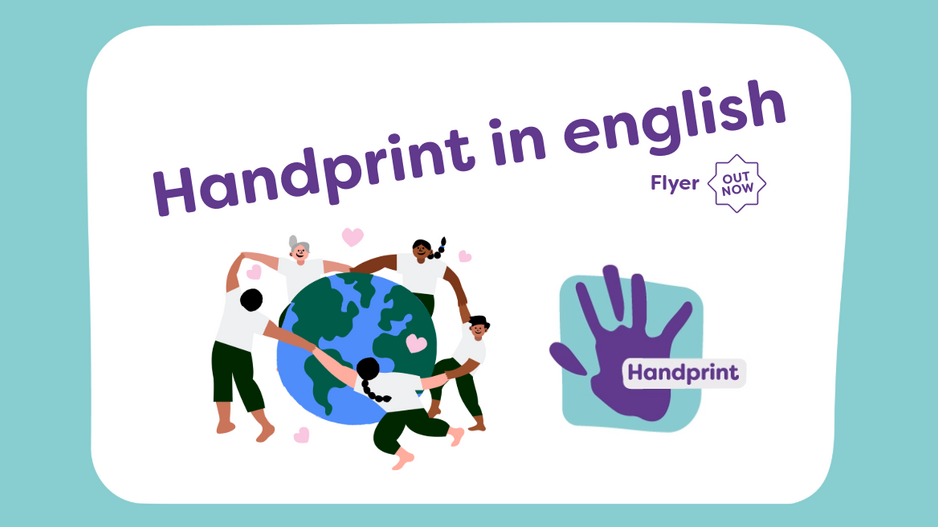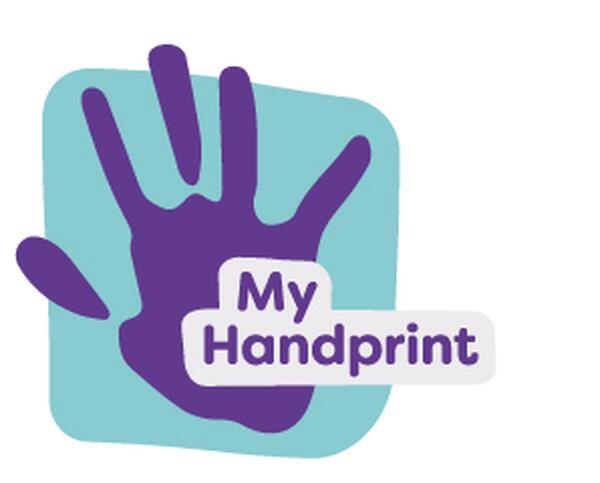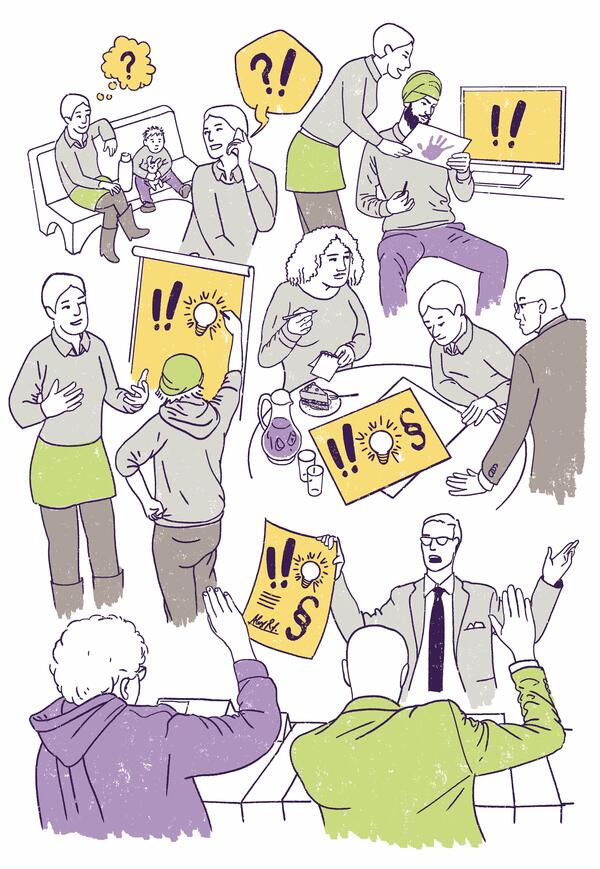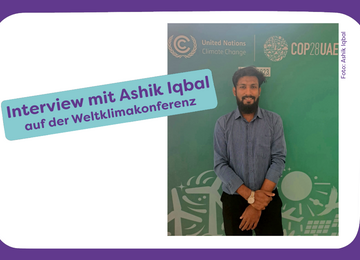The Handprint concept
Changing structures towards sustainability
The handprint is a concept with the claim of "transformative education" and the basis for Germanwatch's educational works, which inspires, empowers, accompanies, and supports transformative engagement. The handprint was originally launched by the Indian organisation CEE (www.ceeindia.org) as an open concept of positive action. Germanwatch has further developed the approach, motivating groups or individuals to focus on transformative, political forms of engagement that have a long-lasting impact on concrete structures. Engagement with the handprint supports groups and individuals to reach their goals.
The Handprint offers three basic entry levels to advance transformation:
- Socially transformative engagement: transforming societal structures in a sustainable way (examples can be found in the list below).
- Politically transformative engagement: encouraging and motivating decision-makers to reshape social structures in the interest of sustainable and resilient development.
- Transformative educational work: empowering people to convert their social structures to be more sustainable or to align with sustainable development goals.
Each of these approaches is about enlarging the handprint of action, which is defined as increasing the positive traces we leave on earth or in our local surroundings. In this context, the handprint stands for the sustainable impact of our actions with the aim of establishing sustainable strucutres as a social standard. Transformative education work can anchor and support people in all three levels. Essentially, the aim is to reflect on and develop options for taking action that address the conditions of structural framework and building skills and ideas to use one's own sphere to shape society. Taking action itself and learning through engagement are the main core aspects to any form of transformative engagement. The concept of the handprint resulted from the theoretical considerations and practical experiences from various actors in education for sustainable development (ESD), political education and global learning.
The Central aspects that make up the Handprint - concept:
Text
- Positive perspective on options for taking action: What can I improve? Where can I leave something good? (Contrary approach to the perspective of the ecological footprint)
- Enabling to get active and involved in political participation in shaping our society towards sustainability
- Learners are considered as a valuable part of the program and not just as consumers, but as builders of their society. They develop greater (self-)efficiency expectation and experience
- Options for taking action which (more or less) correspond to the size of the challenges ("epistemic fit")
- Potential for greater transformative impact to make sustainable behaviour easier for as many people and anchor it in society: strategic and systemic action
- Action-oriented possibilities according to transformation models
- Strengthening the pillars of democracy: Learning from the negotiation process, access to co-design and participation, politicisation (not only for and by the youth), references to politically legitimised frameworks, revitalisation of debate culture, visions of the future.
Examples of specific projects with which groups would leave a lasting Handprint:
Copyright: Germanwatch e.V. | Illustration: Benjamin Bertram
- Initiatives in cities strategically join forces with the goal of convincing the local electricity providers to change their "standard option" (often the so-called basic rate) for customers from a fossil or mixed option to a climate-friendly option composed purely of renewable energies - the new normal.
- Pupils or students at their school or university are committed to ensuring that only seasonal, organic food offered in their canteens, and the meat-free option is the cheaper standard option.
- At the state level, they have been continuing to strengthen an agricultural and nutritional turnaround by campaigning together with other
groups for a quota of food from organic and regional cultivation in public institutions (schools, hospitals, old people's homes, day-care centres...). - Members of religious communities are campaigning for the financial investments of their congregations and national associations to be withdrawn from fossil fuel projects and for stricter procurement guidelines, for example for electronic devices.
- Company employees ask their employers to abolish company cars and to create alternative mobility offers, such as company bicycles or fully paid job tickets. At the same time, they are committed to ensuring that their company publicly positions itself in favour of stronger
incentives for sustainable mobility and against the corporate car privileges and takes this demand to local, regional and national trade and commerce associations. - The residents of a district put the local transition to sustainable agriculture and the protection of biodiversity on the agenda of the district’s election campaign. Together with local farmers, they demanded their district councillors to transform the district into a pesticide-free district and to establish the corresponding regulations. In that way, they intend to raise public awareness to increase public awareness of the issue and to create strong quality criteria for regional agricultural products, making sustainable regional products a more usual option.
Once they were successful when implementing on a smaller scale, many of these approaches can be transferred to the next higher level in the further process. In doing so, we also learn from examples from the Global South.
The educational work on the handprint is not only about discovering these options for action for oneself and finding individual starting points but also about developing strategic steps towards the implementation and tackling them with the necessary perseverance and skills.
Text
Therefore, transformative education should include a competence-oriented accompaniment of transformative engagement within the individual, specific learning and action processes.
We work with a model that contains four learning phases:
- Getting to know the handprint persepctive
- Finding starting points for your own handprint
- Implementing your own handprint projects
- Strategically planning your own handprint projects
What can I do to enlarge my handprint?
Where should I start to enlarge my personal handprint? Where and how can I initiate mayor societal changes, that facilitate more people's sustainable behaviour? Our decision path answers these and other important questions.
Handprint flyer for download
If you would like to download this text as a flyer in PDF format, use the button.
This blog post is written by Karo Snethlage and Stefan Rostock, based on a german article of Marie Heitfeld.
Nachname
Snethlage (sie/ihr)
Firma und/oder Position im Unternehmen
Praktikantin 2023/2024 im Team Bildung für nachhaltige Entwicklung | Germanwatch e.V.
User Biographie
Hallöchen, ich bin Karo! Als Biologin möchte ich durch praktischen Kontakt mit Natur und Klimaschutz Menschen zu nachhaltigerem Verhalten bewegen. Das im Team Bildung für nachhaltige Entwicklung mit BNE-Ansatz umzusetzen, ist einfach eine perfekte Mischung!
Firma und/oder Position im Unternehmen
NRW-Fachpromotor für Klima & Entwicklung | Germanwatch e.V.
User Biographie
Ich bin Teamleiter Bildung für Nachhaltige Entwicklung bei Germanwatch und NRW-Fachpromotor für Klima und Entwicklung. Mit viel Engagement sitze ich in der internationalen Hand Print Steuerungsgruppe und unterstütze verschiedene Gruppen und Initiativen handlungsorientiert bei der strategischen Planung und Umsetzung ihres transformativen Engagements.





Schreibe einen Kommentar